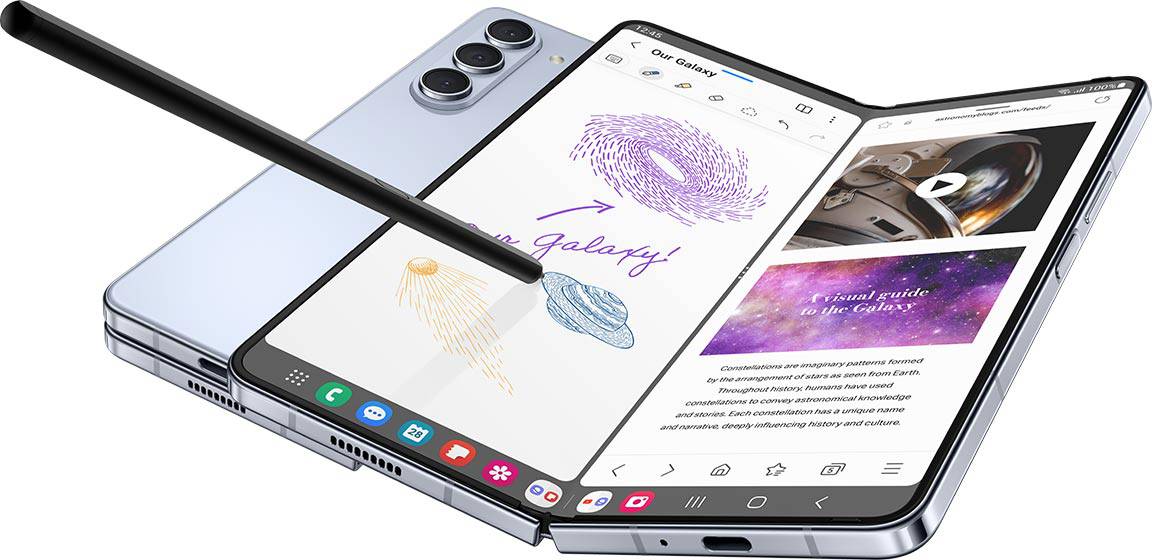Samsung plans to release a triple-screen foldable (tri-fold) phone in 2025, according to a report by Android Authority. This new device will push the boundaries of smartphone design, offering users more screen space and flexibility. The triple-screen foldable phone will feature two hinges, allowing it to unfold into a larger display than current foldable models.
Samsung’s move comes as other companies like Huawei have already launched triple-fold phones. The larger screen size could make these devices more useful for tasks that typically require tablets. This could appeal to users who want a single device for both phone and tablet functions.
The triple-screen design presents new challenges and opportunities for Samsung. The company will need to ensure the device is durable and easy to use. It will also need to create software that takes full advantage of the unique form factor.
Unfolding the Future: Samsung’s Ambitious Triple-Screen Foldable Phone
Rumors are swirling about Samsung’s plans to launch a groundbreaking foldable phone with not one, not two, but three screens. This ambitious device, potentially arriving in 2025, is poised to redefine the foldable phone landscape. Let’s delve into the details and explore what this innovative device might offer.
A Glimpse into the Future of Foldables
Imagine a phone that unfolds twice, revealing a tablet-sized display. This is the vision behind Samsung’s rumored triple-screen foldable phone. Sources suggest that the device will feature two hinges, allowing it to fold in a Z-shape configuration. This design could offer a significantly larger screen area than current foldable phones, opening up new possibilities for multitasking, content creation, and immersive experiences.
More Than Just a Bigger Screen
While the expanded screen real estate is undoubtedly a key feature, Samsung is likely to incorporate other innovations to enhance the user experience. We can anticipate advancements in hinge technology, ensuring smoother folding and improved durability. Moreover, Samsung will need to develop a refined user interface that seamlessly adapts to the triple-screen layout, allowing for intuitive navigation and efficient multitasking.
Challenges on the Horizon
Developing a triple-screen foldable phone presents significant engineering challenges. Samsung will need to address concerns about weight, thickness, and overall device durability. Ensuring the structural integrity of a device with two hinges and three flexible displays will be crucial. Furthermore, optimizing software to take full advantage of the unique form factor will be essential for a seamless user experience.
The Competitive Landscape
Samsung isn’t alone in exploring multi-screen foldable phones. TCL, for instance, has already showcased prototypes of similar devices. This suggests that the foldable phone market is evolving rapidly, with manufacturers pushing the boundaries of design and functionality. Samsung’s triple-screen phone, if released, could solidify its leadership in this dynamic market and spur further innovation.
Potential Impact on the Industry
The arrival of a triple-screen foldable phone could have far-reaching implications for the mobile industry. It could accelerate the adoption of foldable devices, driving down costs and encouraging developers to create apps optimized for larger, more flexible screens. This could lead to a new era of mobile computing, where the lines between phones and tablets become increasingly blurred.
Samsung’s Triple-Screen Foldable: Key Takeaways
| Aspect | Description |
|---|---|
| Release Date | Rumored for 2025 |
| Design | Tri-fold design with two hinges |
| Potential Benefits | Larger screen area, enhanced multitasking, immersive experiences |
| Challenges | Durability, weight, software optimization |
| Impact | Increased competition, potential to drive foldable phone innovation |
Key Takeaways
- Samsung aims to launch a triple-screen foldable phone in 2025
- The new design will offer more screen space than current foldable models
- This move could blur the line between smartphones and tablets
Design Evolution and Innovation
Samsung’s journey in foldable phones shows rapid progress. The company is now moving towards a triple-screen design, pushing the limits of mobile technology.
From Galaxy Z Fold to Tri-Folding Phone
Samsung’s Galaxy Z Fold series marked a big step in foldable phones. The first model had issues, but newer versions fixed many problems. Now, Samsung plans to take things further with a tri-fold phone.
This new design will have three screens that fold out. It’s a big change from the current two-screen setup. The tri-fold phone will likely offer more screen space when opened. This could make it feel more like a tablet than a phone.
The hinges will be key in this new design. They need to be strong and smooth for the phone to work well.
Comparative Analysis with Competitors
Samsung isn’t alone in the tri-fold phone race. Huawei has already launched the Mate XT in China. It has a 10.2-inch screen when unfolded, which is bigger than other foldable phones.
Samsung’s tri-fold phone will need to match or beat this size. It will also have to be thin enough to fit in a pocket. The current Galaxy Z Fold is about 12.1mm thick when folded. Samsung will aim to keep the tri-fold phone close to this thickness.
Other brands like Xiaomi, Honor, and Oppo are also working on tri-fold phones. This means Samsung will face tough competition.
Patents and Anticipated Features
Samsung has filed patents for tri-fold phone designs. These give us hints about what to expect. One design shows a Z-shaped fold, which could offer different screen sizes for various tasks.
The tri-fold phone might include new features to take advantage of its unique form. This could mean better multitasking or new ways to use apps. There’s also talk of adding an HDMI port, which would let users connect the phone to bigger screens easily.
Some challenges remain. Battery life and durability are big concerns with more complex designs. Samsung will need to solve these issues to make a successful tri-fold phone.
User Experience and Functionality
Samsung’s triple-screen foldable phone aims to change how we use our devices. It offers new ways to work and play on a single device.
Multitasking and Productivity Enhancements
The triple-screen design lets users run three apps at once. This means you can write an email, check your calendar, and browse the web all on one device. The extra screen space is perfect for work tasks.
The phone’s software is made to work well with the three screens. It’s easy to move apps between screens or use them together. For example, you can drag and drop text or images from one app to another.
The phone can also turn into a mini laptop. You can use one screen as a keyboard and the others as displays. This makes typing long documents much easier.
Entertainment and Gaming Capabilities
For fun, the triple-screen phone shines. Its large screen is great for watching movies or TV shows. You can fold it to stand on its own, so you don’t need to hold it.
Games look amazing on the big screen. Some games can use all three screens at once. This gives a wider view of the game world. Other games might use one screen for controls and the others for the main action.
The phone can also work as an e-reader. You can fold it like a book and read on two screens at once. This feels more like reading a real book than using a normal phone.
Market Integration and Consumer Considerations
Samsung’s triple-screen foldable phone aims to shake up the smartphone market in 2025. The device faces key challenges in pricing, battery life, and ecosystem integration.
Pricing Strategy and Market Positioning
Samsung must carefully balance innovation and affordability for its triple-foldable phone. The device will likely cost more than current foldables like the Galaxy Z Fold 3 and Z Flip 3. Samsung may position it as a premium offering, targeting early adopters and tech enthusiasts.
A higher price could limit mass market appeal. To offset this, Samsung might offer trade-in deals or payment plans. They could also release a range of models at different price points.
The triple-foldable’s unique features will be key to justifying its cost. Samsung needs to highlight how the extra screen space adds value for work and play.
Battery Life and Hardware Sustainability
Battery life is a major concern for foldable phones. A triple-screen device will need a large battery to power its displays. This poses design challenges, as the phone must remain thin and light.
Samsung may use new battery tech or power-saving features to extend runtime. They could also add fast charging to help users top up quickly.
The folding mechanism’s durability is another key factor. Samsung must ensure the hinges can withstand frequent use. They’ll likely use strong materials and rigorous testing to address this.
Water and dust resistance will be important for daily use. Samsung may build on the IPX8 rating of the Galaxy Z Fold 3 for added protection.
Mobile Division’s Role in Samsung’s Ecosystem
The triple-foldable phone fits into Samsung’s wider ecosystem strategy. It could serve as a flagship device to showcase the company’s tech prowess.
Samsung may create special apps and features that work across its product line. This could include seamless file sharing with Galaxy tablets and laptops.
The device might also push the limits of mobile computing. With its large screen, it could replace tablets for some users. This aligns with Samsung’s goal of blurring device categories.
Samsung’s mobile division will need to work closely with other teams. This includes display tech, software, and chip design. The result could be a highly integrated product that stands out in the market.







